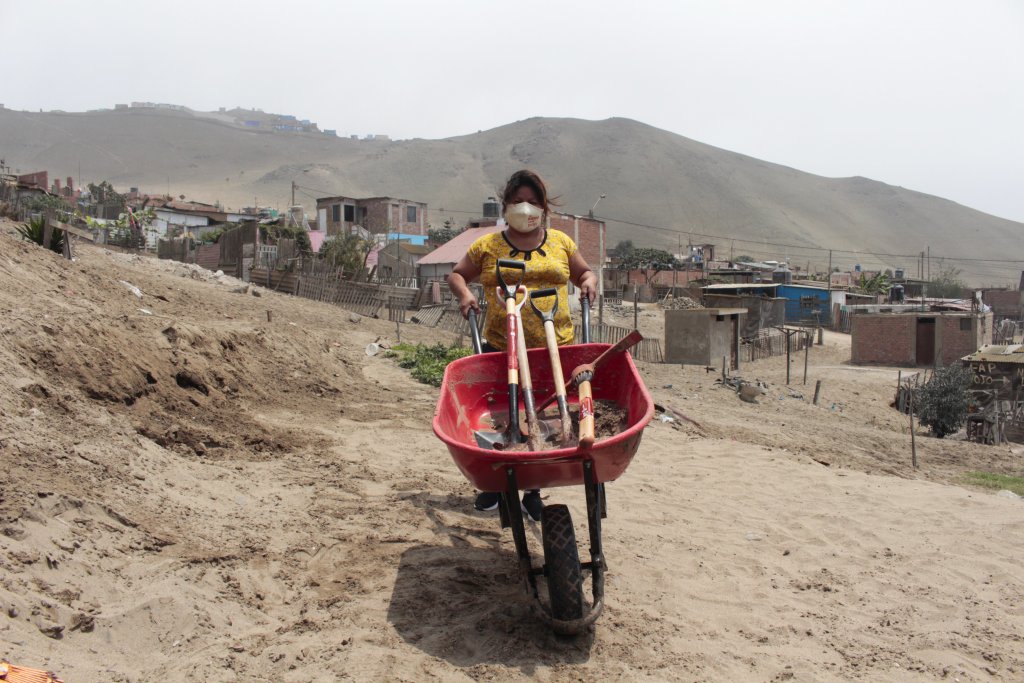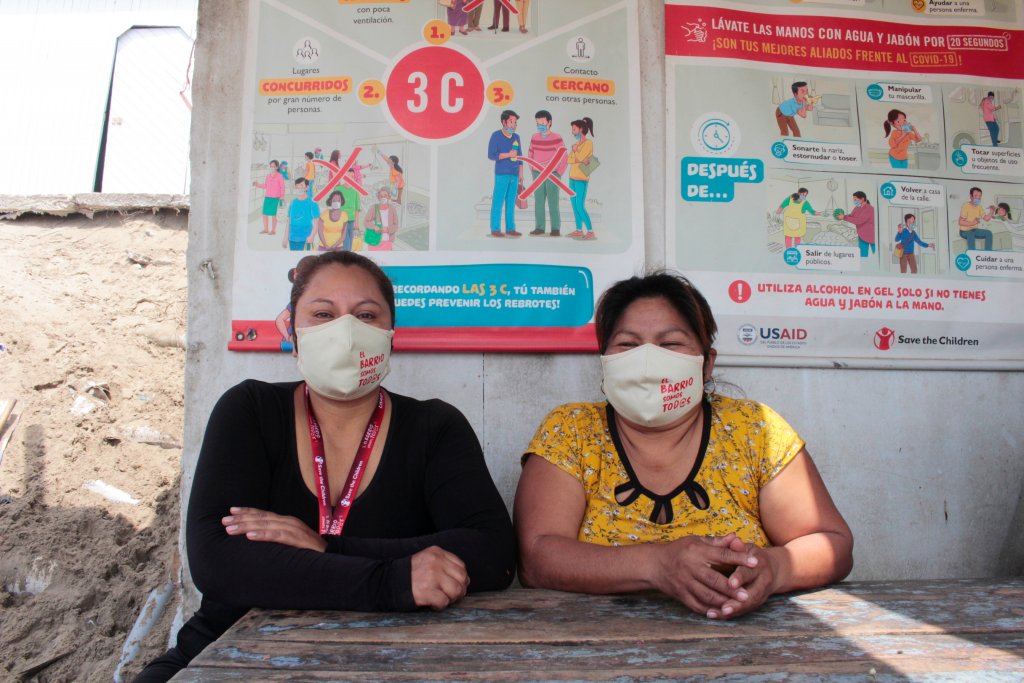Judith and Gerald
Organized community, protected children
Judith is president of the neighborhood board of “Hijos de la Arboleda“, a housing association recently created in the district of Santa Rosa in North Lima. She is also a promoter and leader of one of the community kitchens in her area and a member of the Community-Based Disaster Risk Management Committees (CBDRMC) promoted by Save the Children. She wants families, and especially children like her grandnephew Gerald, to have a better quality of life.
Judith describes herself as a “Jill of all trades”. She is an entrepreneurial woman who stands out for her will to strive tirelessly for her personal progress and for that of her community. Undoubtedly, one of her proudest achievements is to have driven the creation of the “Hijos de la Arboleda” Housing Association as an extension of the La Arboleda Human Settlement. In 2010, she and her neighbors became aware of the need to build more houses so that the families living in overcrowded conditions could improve their situation.

We were so worried seeing that two or three families were living in one house. We came to an agreement and organized a meeting with the people of La Arboleda, we asked them if they would agree to create a new housing association so that our families could have decent housing.
After making the foundation of “Hijos de la Arboleda” a reality and achieving its formalization in 2013, Judith has not stopped. On the contrary, as a leader, she is constantly looking for opportunities that allow her to improve the conditions and quality of life in her area.
And the fact is that in “Hijos de la Arboleda” families live on the sandy slopes of the hills, in houses with fragile and precarious structures, they lack drinking water and are supplied by water tanks. Even throughout the pandemic, residents had difficulty accessing this valuable water resource to adequately protect themselves from the Covid-19 disease.
Undoubtedly, the health crisis exacerbated the precariousness in which the nearly 50 families of this sector live, and this situation is what drives Judith and the women of the community to continue acting and looking for solutions.
There were several families desperately worried because nobody knew what was going to happen in this pandemic. So, talking with the mothers, we decided to start a community kitchen. After that, a second and a third community kitchens ‘Parte alta’ (…) and ‘Mujeres guerreras’ were started. We, as female warriors, fighters, women of courage, look for alternatives to obtain donations for the benefit of the neighbors with fewer resources.
A community that learns and undertakes
Judith came from Ucayali to Lima 14 years ago looking for better opportunities for her four children to study and get ahead. For this reason and for her natural leadership, she has always felt the need to get trained, get involved in her community, and join forces with others.
She is aware that each experience brings its own challenges and learning. Even though she knows that she will not be paid as a leader, she is determined to keep working and encourages others to participate. So, when Judith received an invitation from Save the Children to join the Community Disaster Risk Management Committee, she did not hesitate and began attending talks and training sessions. She admits that she knew nothing about disaster risk prevention and reduction; however, she is now one of the best informed in her community.
We are starting to prepare so that (if a disaster) hit us, it won’t find us unprepared… We already know what can happen, we are going to improve. (…) With the training, we are learning. We have heard why houses get destroyed, it is not because of the earthquake… it is because of the way we build them.
Thus, after receiving a toolkit, materials and safety implements from Save the Children, they decided to set up safe assembly points: a first big step in the process of preparing for an emergency. Cecilia, who works side by side with Judith and chairs the Community DRM Committee of “Hijos de la Arboleda“, says that the idea of organizing to set up the three safe assembly points, one in front of each community kitchen, came about as a result of the constant training provided by Save the Children and the determination and effort of the neighbors involved.

Men work during the day and it is the women who are making progress. We want to show that we are learning and improving. (…) There are stairs that we need to build, we are doing this little by little, we try to support each other.”
To share the knowledge they are acquiring in disaster risk management with the community, these leaders take advantage of their contact with the families through the community kitchens. They use every conversation and interaction to raise awareness about the importance of this topic, which is very relevant due to the vulnerable location of this population. Although both leaders participate actively and have effective mechanisms to communicate the importance of DRM to their neighbors, both Cecilia and Judith recognize that there is still a need for everyone to get involved and participate with greater awareness.
I would like to tell my neighbors (…), that we should focus on the objective, on the benefits that our association is going to have, on all the good that can come (….). The benefit is for our children.
A better future for girls, boys and adolescents
Judith is proud of her great-nephew Gerald, a six-year-old boy, very cheerful and collaborative, who always shows enthusiasm for the activities that take place within the community. For example, during the last family plan drill Judith is proud of her grandnephew Gerald, a very cheerful and cooperative six-year-old boy who is always enthusiastic about activities in the community. For example, during the last family plan drill promoted by Save the Children in his district, Gerald helped to post signs indicating the location of the emergency backpack and the safe and risk areas inside his home. Although Gerald is still very young, he is aware of all the dangers that disasters bring because his great-aunt Judith, his mom and his schoolteacher talk to him about it. He remembers that, during the last earthquake in Lima in June, he was very scared and just ran following his mom and sister.
I felt the ground cracking. I ran, I was with my sister and my mom. We ran outside
Gerald knows that there are landslides and rockslides, which can happen in the area where he lives. So, he has a plan in his imagination. He would like to live high up on the hill because if a tsunami, landslide, or rockfall were to happen, he and his family would be safer and farther away from all those dangers.
I want to live on the hill up there because what if it all collapses. I have a friend who lives up there on the hill, I also want to live up there with him. To play together, but also so that nothing happens to me.
Judith is grateful to Save the Children and the project that is intervening in her community. This motivates her to continue learning and working for a better future for everyone.
It is the first NGO that has been interested in the association and the North Lima area. We have never had an intervention. (Thank you for) caring, we need it. (We needed to know) what risks we were facing. What we want is to have harmony for the improvement of our human settlements. If there is no dialogue, there is nothing.
About the intervention
Save the Children, with the support of USAID’s Bureau for Humanitarian Assistance (BHA), implements this project “Strengthening of the Inclusive Approach to Disaster Risk Management in North Lima, that will build the technical and strategic capacity of the municipalities of Ancon and Santa Rosa, both extremely vulnerable due to their proximity to the sea and the difficult geography on which the homes of the low-income families living in the area are built.
Through this project, Save the Children promotes the protection of the most vulnerable children and adolescents in the area, since by improving the living conditions of their communities and homes, every one of them will have better opportunities to have a safe and dignified life that will allow them to develop healthy and happy.
.png)




